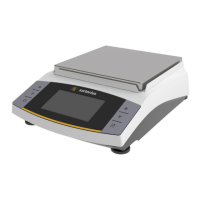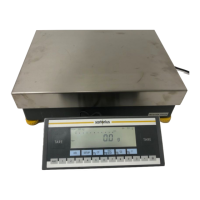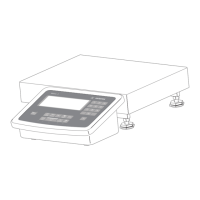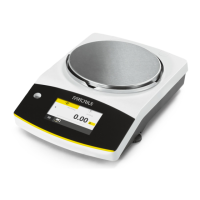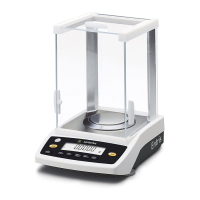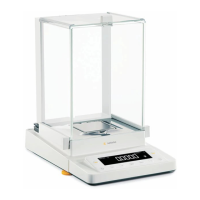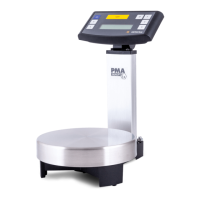Do you have a question about the Sartorius AZ214 and is the answer not in the manual?
Ensures safe operation and prevents damage to the balance by following essential safety instructions.
Guidelines for protecting the balance from environmental factors during storage and transit.
Procedure for unpacking the balance and checking for any visible damage upon receipt.
Advice on selecting an optimal location, avoiding heat, drafts, and vibrations for balance installation.
Steps to acclimatize the balance to room temperature to prevent condensation before use.
Instructions for assembling components within draft shield chambers with sliding doors.
Steps for assembling the draft shield base and cover for balances featuring glass draft shields.
Procedure for correctly placing the pan support and weighing pan for different balance types.
Procedure for connecting the balance to the mains power supply using the provided AC adapter.
Guidance on how to choose between 230 V and 115 V for the balance's power supply.
Instructions on how to properly level the balance using its adjustable feet for precise measurements.
Details on using the rear mounting lug to secure the balance against theft at the installation site.
Description of the balance's display indicators, symbols, and functional keys.
Essential preparation steps before performing a basic weighing, including powering on and taring.
Explanation of the required warmup time for the balance to achieve optimal operating temperature.
A practical step-by-step example illustrating the execution of a basic weighing operation.
Conditions necessary for calibration and the available weight units for adjustment.
A detailed example demonstrating the steps involved in calibrating the balance with a calibration weight.
Steps to configure the Net-Total Formulation application via the balance's operating menu.
A practical example showing how to weigh and record components for mixture formulation.
Explains how the counting program identifies and quantifies items based on their average weight.
Instructions for setting up the counting program, including reference sample quantity selection.
A step-by-step example demonstrating how to determine the count of unknown items.
Describes how to obtain weight readings as a percentage of a defined reference weight.
Steps to set up the weighing in percent application, including reference percentage values.
A practical example demonstrating how to measure an unknown weight as a percentage.
Explains how to get stable weight readings in unstable conditions by averaging multiple measurements.
Instructions for setting up the weigh averaging application, specifying the number of subweighs.
A step-by-step example for calculating an average weight from multiple subweighing operations.
Instructions for setting up the application to switch between two different weight units.
How to use the 'F' key to toggle the display between the primary and secondary weight units.
A guide to using menu codes to configure specific balance parameters, illustrated with an example.
Detailed breakdown of the balance's operating menu, including levels, options, and factory settings.
Settings for data interface parameters such as parity, stop bits, and communication modes.
Settings for printout formats, including ISO/GLP compliance and line formatting.
Configuration of extra functions like external switch control, power-on modes, and menu reset.
Information on the data included in GLP header and footer, such as date, time, and manufacturer.
Menu codes and settings required to enable and customize ISO/GLP-compliant record output.
Explanation of function keys for initiating header output, reference data, and application termination.
Explains the balance's interface port functionality and preparation for external device connections.
Detailed pinout chart for the 25-pin RS-232 female interface connector used for data communication.
A guide to balance error codes, their causes, and the recommended steps for resolution.
Guidance on professional servicing, repair limitations, and procedures for cleaning the balance and its parts.
Specific instructions for cleaning and maintaining stainless steel components of the balance.
Steps to take if the balance's safe operation with the AC adapter is compromised.
Information on recycling balance packaging and options for disposing of old weighing equipment.
Detailed technical specifications for AZ214, AZ124, and AZ64 balance models.
Detailed technical specifications for AZ313, AZ153, AZ3102, AZ1502, and AZ612 balance models.
Detailed technical specifications for AZ212, AZ6101, AZ4101, AZ2101, and AZ601 balance models.
Listing of optional accessories including data printers, remote displays, and data transfer software.
Details on external rechargeable battery packs, RS-232C interface cables, and connectors.
Information on universal remote control switches and carrying cases for balance protection.
Information on protective dust covers designed for operating elements and specific balance models.
Listing of various weighing bowls and scoops with specifications and order numbers for different capacities.
Listing of calibration weights required for specific Sartorius balance models and their accuracy classes.
Official declaration confirming the equipment's adherence to specified European EMC and safety directives.
Ensures safe operation and prevents damage to the balance by following essential safety instructions.
Guidelines for protecting the balance from environmental factors during storage and transit.
Procedure for unpacking the balance and checking for any visible damage upon receipt.
Advice on selecting an optimal location, avoiding heat, drafts, and vibrations for balance installation.
Steps to acclimatize the balance to room temperature to prevent condensation before use.
Instructions for assembling components within draft shield chambers with sliding doors.
Steps for assembling the draft shield base and cover for balances featuring glass draft shields.
Procedure for correctly placing the pan support and weighing pan for different balance types.
Procedure for connecting the balance to the mains power supply using the provided AC adapter.
Guidance on how to choose between 230 V and 115 V for the balance's power supply.
Instructions on how to properly level the balance using its adjustable feet for precise measurements.
Details on using the rear mounting lug to secure the balance against theft at the installation site.
Description of the balance's display indicators, symbols, and functional keys.
Essential preparation steps before performing a basic weighing, including powering on and taring.
Explanation of the required warmup time for the balance to achieve optimal operating temperature.
A practical step-by-step example illustrating the execution of a basic weighing operation.
Conditions necessary for calibration and the available weight units for adjustment.
A detailed example demonstrating the steps involved in calibrating the balance with a calibration weight.
Steps to configure the Net-Total Formulation application via the balance's operating menu.
A practical example showing how to weigh and record components for mixture formulation.
Explains how the counting program identifies and quantifies items based on their average weight.
Instructions for setting up the counting program, including reference sample quantity selection.
A step-by-step example demonstrating how to determine the count of unknown items.
Describes how to obtain weight readings as a percentage of a defined reference weight.
Steps to set up the weighing in percent application, including reference percentage values.
A practical example demonstrating how to measure an unknown weight as a percentage.
Explains how to get stable weight readings in unstable conditions by averaging multiple measurements.
Instructions for setting up the weigh averaging application, specifying the number of subweighs.
A step-by-step example for calculating an average weight from multiple subweighing operations.
Instructions for setting up the application to switch between two different weight units.
How to use the 'F' key to toggle the display between the primary and secondary weight units.
A guide to using menu codes to configure specific balance parameters, illustrated with an example.
Detailed breakdown of the balance's operating menu, including levels, options, and factory settings.
Settings for data interface parameters such as parity, stop bits, and communication modes.
Settings for printout formats, including ISO/GLP compliance and line formatting.
Configuration of extra functions like external switch control, power-on modes, and menu reset.
Information on the data included in GLP header and footer, such as date, time, and manufacturer.
Menu codes and settings required to enable and customize ISO/GLP-compliant record output.
Explanation of function keys for initiating header output, reference data, and application termination.
Explains the balance's interface port functionality and preparation for external device connections.
Detailed pinout chart for the 25-pin RS-232 female interface connector used for data communication.
A guide to balance error codes, their causes, and the recommended steps for resolution.
Guidance on professional servicing, repair limitations, and procedures for cleaning the balance and its parts.
Specific instructions for cleaning and maintaining stainless steel components of the balance.
Steps to take if the balance's safe operation with the AC adapter is compromised.
Information on recycling balance packaging and options for disposing of old weighing equipment.
Detailed technical specifications for AZ214, AZ124, and AZ64 balance models.
Detailed technical specifications for AZ313, AZ153, AZ3102, AZ1502, and AZ612 balance models.
Detailed technical specifications for AZ212, AZ6101, AZ4101, AZ2101, and AZ601 balance models.
Listing of optional accessories including data printers, remote displays, and data transfer software.
Details on external rechargeable battery packs, RS-232C interface cables, and connectors.
Information on universal remote control switches and carrying cases for balance protection.
Information on protective dust covers designed for operating elements and specific balance models.
Listing of various weighing bowls and scoops with specifications and order numbers for different capacities.
Listing of calibration weights required for specific Sartorius balance models and their accuracy classes.
Official declaration confirming the equipment's adherence to specified European EMC and safety directives.
| Maximum Capacity | 210 g |
|---|---|
| Readability | 0.1 mg |
| Pan Size | Ø 80 mm |
| Display | Backlit LCD |
| Power Supply | AC Adapter |
| Operating Temperature | +10°C to +30°C |
| Repeatability | 0.1 mg |
| Linearity | ±0.2 mg |
| Calibration | Internal |
| Interface | RS-232 |
| Units | g, mg, ct, oz |


